The IRA’s War on Public Entertainment – The Amusements Order of 1923.
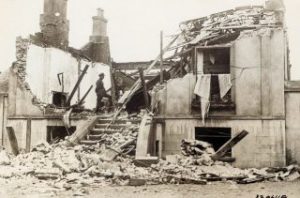
How the anti-Treaty IRA forbade ‘public amusements’ at a ‘time of national mourning’. By John Dorney
On the morning of April 20, 1923, the doorman of the Corinthian cinema on Dublin’s Eden Quay, was ‘held up by two armed men’, who told him they ‘intended to blow up the theatre’.
He warned them that there were women and children inside- the family of the owner, who resided on the premises – but they told him they had ‘no time to wait’. They placed a bomb in the door of the cinema, lit a two inch long fuse on it and made their getaway.
To the relief of the door man the fuse was faulty and burned itself out before detonating. The mine was removed by CID detectives from Oriel House.[1]
The anti-Treaty IRA campaign against ‘public amusements’ during what it termed ‘a period of national mourning’ was one of the stranger features of the Irish Civil War of 1922-22. In an effort to resurrect the Irish Republic it believed had been abandoned by the Anglo-Irish Treaty, the IRA had embarked on a campaign of bombing theatres and cinemas throughout the Irish capital, Dublin. How had the guerrilla army come to this?
Context –executions and reprisals
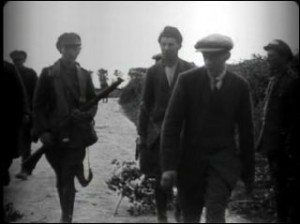
In late 1922, the Provisional government of the Irish Free State had embarked on a policy of official executions, by which it hoped to coerce the anti-Treaty guerrillas into calling off their campaign against the new state. By the end of January 1923 over 50 had died before the firing squads.
In February 1923, the government temporarily halted executions and issued an amnesty for those ‘irregulars’ who gave themselves up. Despite the surrender of some prominent anti-Treatyites such as Liam Deasy, on the whole this had little effect and though the government’s National Army was gradually wearing down the armed resistance of anti-Treaty Republican forces, the war stubbornly stuttered on.
March 1923, saw a series of brutal reprisal massacres of anti-Treaty IRA prisoners in Kerry (twenty nine men were killed in all), by pro-Treaty troops as well as a restarting of official executions on March 13, which accounted for ten more deaths by firing squad before the end of the month. The anti-Treatyites retaliated, with several ‘executions’ of unarmed National Army troops, including three in Dublin, another three in Wexford and up to four more in Tipperary. [2]
The IRA ordered: ‘it is ordered that a time of national mourning be proclaimed, all sport and amusements be suspended, all picture houses [cinemas] and theatres and other places of public amusement be closed,
Liam Lynch, the IRA Chief of Staff and the man responsible, more than any other, for the continuance of the Republican guerrilla campaign, in fact disapproved of some of these attacks on the grounds that some of the soldiers were unarmed. In any case, he had his own answer to the renewal of executions.
Once, in the early days of the Civil War, Liam Lynch had issued orders that civilians were not to be interfered with under any circumstances, even if they were passing information to the pro-Treaty authorities. Now he issued orders that were almost the polar opposite, ordering that civilians must be coerced into mourning for the Republican dead.
The Amusements Order
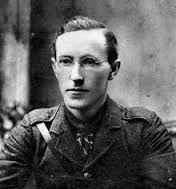
When executions were re-started on 13 March 1923, Lynch responded by issuing the ‘Amusements Order’ which declared that: ‘it is ordered that a time of national mourning be proclaimed, all sport and amusements be suspended, all picture houses [cinemas] and theatres and other places of public amusement be closed, especially horse riding, hunting, coursing, dancing and outdoor sports. Anyone refusing this order will be treated as an enemy of the Republic.’[3]
The Amusements Order had first been discussed in January 1923 and drafted in February. While there had already been a bomb attack on a cinema in Dublin – a ‘mine’ at the Pathe Freres Cinema on Lower Abbey Street in February the injured eight civilians[4] and the Rotunda theatre was burned in November 1922 – it was only after the executions resumed that it was issued.
Eamon De Valera, the anti-Treatyites’ political leader, while warning Lynch that ‘our ultimate hope of success is based on winning the people to our side [and] anything that savours wanton disregard of their interests will operate against this hope’, agreed reluctantly to approve the order. Of the public at large he wrote: ‘I admit that they do not deserve much consideration for they seem indifferent to the judicial murders going on.’[5]
The amusements order was a somewhat nihilistic attempt to share the suffering of the anti-Treatyites among the general public, a lashing out at a public that had, by and large, rejected them. But it also made some tactical sense.
The Free State’s war aim was to return ‘settled conditions’ where normal life resumed in so far as possible and the ‘Irregulars’ were reduced to an irrelevance. The Amusements Order was an attempt to show that, despite military defeat, despite the failure of such schemes as the attempt to collect for the Republic dog licenses and other taxation, the anti-Treaty IRA could still coerce the public.
Implementing the Order
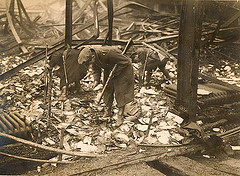
Around the country, the Amusements Order had some strange results. In Ballina, County Mayo, the National Army reported that the ‘Irregulars’ had demolished the enclosure at a coursing meeting and released the hares to prevent the coursing from going ahead.[6]
In Dublin also there were some eccentric manifestations of it, golfing at Portmarnock was disrupted by armed men for instance, who ordered the golfers home.
Interestingly enough, the order does not seem to have been applied to popular field sports. The Football Association of Ireland Cup Final, for instance, was held without disruption in Dublin’s Dalymount Park on March 17, 1923, watched by 14,000 people, in the midst of the IRA’s prohibition on public entertainments. [7]
For those businesses which were targeted, there were serious ramifications, however. Cinemas and theatres in Dublin were delivered a threatening notice ordering them to close.
The Government was horrified to learn that ‘the majority of theatres and cinemas closed in the city of Dublin in compliance with threatening orders by the Irregulars’ on 15 March. Outraged at the challenge to its authority in the capital, the Government placed hefty fines on any cinema or theatre that closed and dispatched elements of the Army, CID, Protective Corps and CDF to guard them. Punitive measures were also taken against anti-Treaty prisoners, ‘no letters, no parcels, no tobacco’ until the Amusements Order was withdrawn.[8]
The Siki-McTigue fight
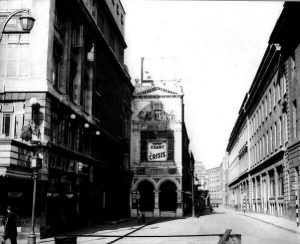
Almost incredibly, given the times, on 17 March, St Patrick’s Day, Dublin was due to host a major boxing match, the world heavyweight title fight between an Irish fighter Mike McTigue and a Frenchman, Louis Mbarick Fall (better known as ‘Battling Siki’) at La Scala Theatre on Prince’s Street, just beside the GPO.
Even with the Civil War violence winding down in Dublin (at least it had been, up to the second week of March) it still seems remarkable that the fight went ahead. [9]
That it occurred just after Lynch had issued the Amusements Order heightened the risks even further. The scenario around the Amusements Order, and the Siki fight in particular, was the closest the Irish Civil War in Dublin came to what we might call out and out terrorism – that is deliberate mass violence against civilians.
Attempts were made to bomb a world title boxing match held in Dublin on St. Patrick’s Day 1923.
The IRA Dublin Brigade had orders to disrupt the fight and enforce the ban on public entertainments and planned to bomb the theatre, despite the risk of mass civilian casualties. Second Battalion reported that it tried to blow up La Scala’s power station, but found ‘it had a strong guard on it’ and settled for detonating a mine in nearby Henry Place instead, flying glass from which injured two bystanders.[10]
When questioned by his superior on why the fight had not been prevented, the commander of Dublin IRA’s Second battalion responded that La Scala was so heavily guarded that it was a ‘regular death trap’.[11]
A battalion of regular Free State troops guarded the fight, searching all 2,000 spectators as they entered the theatre. They reported that the mine was laid by ‘two girls and one man with a Thompson gun’, who got away in a car. When another car pulled up outside, the troops opened fire, fearing a follow up attack, but the vehicle turned out to be a CID car. One CID officer was wounded, another was arrested and brought to Oriel House, where it was verified he was a CID detective.[12]
This was not the last incident of ‘friendly fire’ that night – an indication of the nervousness of pro-Treaty troops. Colonel McDonnell, the commander of the National Army Dublin Brigade, was shot and seriously wounded by his own troops when his car ‘failed to halt’ at Kingsbridge.
Another soldier was accidentally shot and killed in Collins Barracks.[13] Meanwhile, across town at the Theatre Royal, on Hawkins Street, there was an attempt by the anti-Treatyites to shoot Frank Bolster, the National Army Intelligence officer with a ferocious reputation for mistreatment of prisoners and a member of the ‘Murder Gang’. He and another officer were wounded.[14]
‘Hit them up’
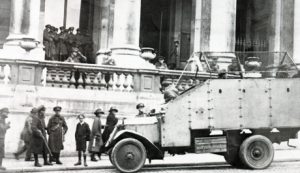
There were some sharp rebukes within the IRA for the Dublin Brigade that the Siki-McTigue fight was allowed to take place.
Liam Lynch wrote indignantly to IRA Director of Intelligence Michael Carolan that it was ‘very disappointing’ that the fight had not been prevented from going ahead. He had, he wrote, ‘expected to La Scala go up’ and demanded ‘action be taken against those who flout the warning’ on public entertainments’.
He told the Director of Intelligence and the commander of the Dublin Brigade, Frank Henderson, that they had, ‘better make a success of something… ‘blow up a picture house, theatre or a residence with a mine’. It was he said, a ‘a disgrace that the enemy can attend dances’ in peace and cited for example a dance organised by the pro-Treaty women’s group Cumann na Saoirse that was held on St Patrick’s Day and attended by soldiers and Free State detectives at Dublin’s Mansion House. ‘Hit them up’ Lynch ordered. [15]
IRA Chief of Staff Liam Lynch was scathing about the Dublin Brigade’s failure to impose the Amusements Order and ordered cinemas, theatres and dances to be ‘hit up’.
And so, on the urging of IRA GHQ, in the days that followed, there was a second wave of attacks on public entertainments in Dublin, which could have easily caused carnage among the Dublin public.
A mine was laid at the Fountain Cinema which failed to go off and one actually did explode at the Grand Central Cinema on O’Connell Street, causing ‘extensive damage’ and wounding two passersby in late April. While the intention was to damage property, not people, it would have only taken one mistimed bomb for a massacre to have taken place in a crowded cinema.[16]
As it was though, only one man died in the anti-Treatyites’ campaign against public entertainments and he was one of their own fighters. Patrick O’Brien of First Battalion was shot dead by National Army troops on 24 March, after laying bomb at the Carlton Cinema on O’Connell Street.[17]
National Army troops came upon the cinema just as flame leaded from its front door. As they approached the mine detonated and the two anti-Treaty fighters who had laid it opened fire on the troops before trying to flee down North Earl Street. A National Army officer told the subsequent inquest that he ordered ‘five rounds rapid fire’ at the two men, the taller of whom, O’Brien fell, mortally wounded.[18]
The other man seems to have been Martin Hogan, an IRA volunteer originally from Tipperary, who was wounded in the hand in the incident. Hogan himself was killed, shot after arrest about a month later.[19]
The brief resurgence of anti-Treaty attacks in Dublin in response to the March executions could not be sustained. An internal IRA document of April 6, captured by the National Army in May, complained about ‘marked inactivity in Brigade area’. It reminded Battalion commanders that the ‘Amusements Order will have to be enforced’ and that ‘posts must be constantly attacked’ and bemoaned the lack of ‘midnight fusillades’ or gun attacks on Barracks which had been regular occurrences in 1922.[20] Though some such attacks occurred in the spring of 1923, they caused virtually no casualties.
The Irish Civil War finally ended in late May 1923. Liam Lynch was killed in the Knockmealdown mountains on April 10 and Frank Aiken, his successor as Chief of Staff called a ceasefire on April 30 and a ‘Dump Arms’ order on May 24.
The final attacks of the IRA campaign against public entertainment seem to have occurred in late April, 1923, just before the IRA ceasefire. The Irish Times reported, as well as a bomb on the Dublin to Drogheda train at Amiens Street station and a mine explosion wrecking a drapery shop in Rathmines, an attempt to blow up the Grand Central Cinema on O’Connell Street, which blew off some of the marble steps and damaged the entrance but otherwise left the cinema intact. [21]
The end of the campaign
Gavin Foster writes that there was some attempt to revive the campaign against public entertainments in late 1923 as a protest at the continued detention of republican prisoners, but this phase seem to have been far less violent than that before the ceasefire.[22]
Some of those anti-Treaty fighters involved in the campaign met a violent death themselves; five anti-Treaty volunteers assassinated by clandestine pro-Treaty forces in Dublin in late March and early April 1923
Some of those anti-Treaty fighters involved in the campaign, notably Martin Hogan, met a violent death themselves; five anti-Treaty volunteers assassinated by clandestine pro-Treaty forces in Dublin in late March and early April 1923.[23]
If we accept that such civil wars are essentially contests in who can control the civilian population then perhaps we should not be surprised by the belligerents using violence in order to coerce civilians.
Today we are familiar with mass indiscriminate violence against civilians being used as a tactic by armed insurgent groups. Bombs in trains stations, airports, concert venues and cinemas no longer shock as they once did.
While this type of violence was not the primary feature either of the Irish Civil War or of the anti-Treaty IRA’s campaign in general, the episode of the Amusements Order demonstrates, perhaps the potential of all armed conflict to degenerate into outrage and nihilism.
This is an adapted extract from John Dorney’s book The Civil War in Dublin.
References
[1] Irish Times April 21, 1923
[2] See John Dorney, The Civil War in Dublin (Merrion, 2017), p.245-246, for the February amnesty and the Wexford shootings, see Michael Hopkinson, Green Against Green, The Irish Civil War, p.222 and p.246, for Tipperary see https://www.theirishstory.com/2017/04/28/civil-war-casualties-in-county-tipperary/#.Wm3fMHzLjIU though only soldier there was positively identified as having been killed and secretly buried there in March 1923.
[3] De Valera Papers UCD P150/1710.
[4] Irish Times, February 10 1923
[5] De Valera Papers UCD P150/1710
[6] Historian Eunan O’Halpin wondered ‘what on earth possessed them’ but wise or not, what the local anti-Treatyites were doing was enforcing an order that came down from IRA GHQ: O’Halpin, Defending Ireland, p. 28.
[7] Shelbourne of Dublin were defeated Alton United of Belfast 1-0. The GAA’s hurling intermediate league final between Fontenoy and Colberts also went ahead at without incident at Croke Park on April 8, although the attendance was reported as ‘not too packed’, Irish Times, March 18 and April 9, 1923.
[8] Cabinet Minutes 15/3/1923 Mulcahy Papers UCD P7/B/247.
[9] Gallimore, Andrew, A Bloody Canvass, The Mike McTigue Story, pp.122-134
[10] Dublin I Brigade reports 17/3/1923 Twomey Papers UCD P69/20, Irish Times, 18 March 1923.
[11] DI to CS, 21/3/1923 Twomey Papers, UCD P69/11, IRA Intelligence.
[12] Military Archives, (Cathal Brugha Barracks (MA) Dublin Command Reports CW/OPS/07/03.
[13] The dead soldier was Private John Little MA CW/OPS/07/03.
[14] Irish Times, 18 March 1923.
[15] CS to DI, 17/3/1923 Twomey Papers, UCD P69/11, IRA Intelligence.
[16] Twomey Papers UCD P69/20, Irish Times, 28 April 1923.
[17] NA Dublin Reports CW/OPS/07/03. The Irish Times identifies O’Brien as being from 28 Cadogan Road the Clontarf area of the city and says he was shot at the Masterpiece Cinema on Talbot Street.
[18] Irish Times, March 31, 1923.
[19] Martin Hogan, Military Pension file DP 4458
[20] Captured Documents IE/MA/Capt/Lot13.
[21] Irish Times, May 5, 1923
[22] Gavin Foster, Will the Show Go on?, History Ireland, March/April 2017 http://www.historyireland.com/volume-25/issue-2-marchapril-2017/features-issue-2-marchapril-2017/will-show-go/
[23] See Dorney, the Civil War in Dublin, p.249-250. They were; Bobby Bonfield, Thomas O’Leary, Joseph Kiernan, Christie Breslin and Martin Hogan.